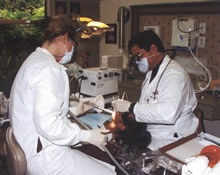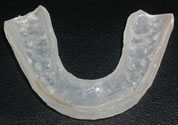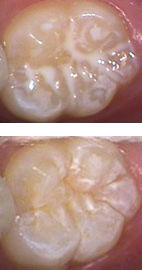
Cleaning
Your regularly scheduled check-up is often referred to as a “cleaning”, but there is much more to it than that! The technical term is oral prophylaxis, which means prevention of oral disease.
Show allYour regularly scheduled check-up is often referred to as a “cleaning”, but there is much more to it than that! The technical term is oral prophylaxis, which means prevention of oral disease.
One way to prevent oral disease is to remove harmful plaque and tartar (calculus) both above and below the gum line. You may also be given special instructions on brushing or flossing to keep clean the areas where we found significant build-up. That is the familiar “cleaning” part of your check-up.
It’s easy to tell which tooth has been “cleaned” in this photo!
Another way to prevent oral disease is by early detection and treatment. During your check-up you will be screened for many potential threats to your oral health, including:
- Cavities
- Gum Disease
- Oral cancer
In addition, some systemic diseases, such as diabetes, often present themselves first inside the mouth, so early detection extends beyond just oral disease.
Your Dental Hygienist is your first-line of defence against oral disease. Your hygienist is a highly trained professional who can evaluate your teeth and gums, both visually and with the assistance of x-rays and other modern technology, to discover threats to your oral or general health. Your dentist will review the findings of your hygienist and advise you on any threats to your oral or general health.
Show lessInfection Control
Dr. Loar share your concern about the spread of disease and work hard to safeguard their patients, and staff, against infection.
Show allDr. Loar share your concern about the spread of disease and work hard to safeguard their patients, and staff, against infection.
When you visit our office, you will see a clean office carefully maintained by well-trained staff. Our dental team always wear gloves, eye protection and complete protective wear during each procedure. After each patient, they discard those gloves, wash their hands and put on a new pair of gloves.
Your protection starts long before you ever enter the treatment room. Here are a few of the things that you don’t see: All surfaces are cleaned and disinfected, staff members sterilize all instruments after their use and dispose of anything that is potentially infectious.
Dr. Loar and their staff want you to know that your protection, care and comfort are our top priorities. That is why we meet, or exceed, the highest infection control standards.
If you have any concerns or questions, please contact us.
Show less
Micro-dentistry
What is Micro-dentistry?
Micro-dentistry is a new, alternative way to treat decay in teeth. The idea behind this technology is to remove as little of the natural tooth as possible while removing all of the decay. With the advent of our new bonding techniques, decay indicating dyes, magnification, fiber-optic lights and white filling materials, decay can be conservatively removed from a tooth and a filling placed that will restore a tooth to its original strength and beauty.
Show allWhat is Micro-dentistry?
Micro-dentistry is a new, alternative way to treat decay in teeth. The idea behind this technology is to remove as little of the natural tooth as possible while removing all of the decay. With the advent of our new bonding techniques, decay indicating dyes, magnification, fiber-optic lights and white filling materials, decay can be conservatively removed from a tooth and a filling placed that will restore a tooth to its original strength and beauty.
Over 90% of the time, we do not need to make you numb to do micro-dentistry and air abrasion so we can eliminate the need for a shot. With the reduced need for anesthetic, we can complete more work in a shorter amount of time since we can work in multiple areas of your mouth in the same appointment. In addition to saving time, you will enjoy the reduction of noise normally caused by a traditional dental drill.
How is this done?
We use air-abrasion, which is a relatively new process in which a fine, pressurized stream of aluminum oxide powder is used to remove the small decayed pits and fissures in teeth. Research studies have shown that in the absence of smoking and coffee drinking, if a patient has dark stained pits in their teeth, decay is present over 90% of the time underneath the stains. In Dr. Loar’s office we believe very strongly in prevention and early treatment of disease. It just makes good sense to treat small cavities early with conservative micro-dentistry than to wait for things to get worse.
The technique:
 Small cavities are identified and scheduled for early treatment.
Small cavities are identified and scheduled for early treatment.
 The teeth are isolated either with rubber dam or cotton rolls and the decay is removed with the air-abrasion machine, under magnification and special light sources in a very conservative manner.
The teeth are isolated either with rubber dam or cotton rolls and the decay is removed with the air-abrasion machine, under magnification and special light sources in a very conservative manner.
 Special cavity stains are used to chemically stain decay in the teeth to help us see any small spots so nothing is missed. Once rinsed off, the tooth is now ready for the filling.
Special cavity stains are used to chemically stain decay in the teeth to help us see any small spots so nothing is missed. Once rinsed off, the tooth is now ready for the filling.
 The prepared tooth is treated with an etching solution to roughen the surface and get it ready for the bonding process. Once “etched”, the tooth is ready for bonding agents and the conservative filling. We use special lights to harden the filling and then complete the process by polishing the filling.
The prepared tooth is treated with an etching solution to roughen the surface and get it ready for the bonding process. Once “etched”, the tooth is ready for bonding agents and the conservative filling. We use special lights to harden the filling and then complete the process by polishing the filling.
 The surface is sealed and protected leaving the tooth restored to its original strength and beauty.
The surface is sealed and protected leaving the tooth restored to its original strength and beauty.

Micro-dentistry is an excellent preventative treatment for those who share our belief that early, conservative care is ideal. You can have decay removed without a shot, loud noise, or bad smells. If you have any questions, just ask us about this new and exciting technology.
Show less
Night Guard
Since most of the damage typically caused by bruxism is during sleep, a night guard can usually be made to stop further damage. A night guard is custom made to fit over the upper or lower teeth. With the night guard in place, the patient can’t grind their teeth together and cause further damage.
Show allSince most of the damage typically caused by bruxism is during sleep, a night guard can usually be made to stop further damage. A night guard is custom made to fit over the upper or lower teeth. With the night guard in place, the patient can’t grind their teeth together and cause further damage.
What is Bruxism?
Grinding of teeth, also known as Bruxism, occurs in children as well as adults. Grinding of teeth generally occurs during sleep.
What if my Child is Grinding His or Her Teeth?
Children often grind their teeth when their teeth are erupting. This is not uncommon, nor is it a problem if it is mild. However, in more severe cases the child can develop a malocclusion. Malocclusion may then lead to TMJ problems or to a need for Orthodontics. If you have any concerns about your child’s Bruxism, be sure to have Dr. Loar check for signs of excessive wear so that treatment options can be discussed and implemented to prevent serious problems.
What about Bruxism in Adults?
Adults may grind their teeth at night due to:
-
Malocclusion
-
Stress
The result of bruxism can be:
Worn spots (attrition) that can lead to:
-
Malocclusion (if the patient doesn’t have already)
-
Sensitivity
-
Brittle teeth that require crowns
-
TMJ problems
-
Noise that sometimes disrupts the partner’s sleep.
How can Bruxism be Treated?
Sometimes, the damage caused by bruxism must be addressed first. Any malocclusion, sensitivity, brittle teeth, or TMJ problems should be discussed with Dr. Loar first to be sure those problems are resolved and that the subsequent treatment for bruxism prevents a recurrence of those problems. Further damage from bruxism can be prevented with a mouth guard that is worn during sleep. This guard is comfortable and easy for most people to wear. Contact Us for an appointment to stop the damage caused by bruxism and correct any serious problems.
Show less
Sealants
Molars Trap Food and Bacteria
The most common area for children to get decay (like most adults) is on their permanent back teeth (molars). The molars have very deep grooves and pits on the chewing surfaces. This is where food and bacteria hide and form cavities. No matter how well your child brushes, it is nearly impossible to remove all of the bacteria from these grooves and pits.
Show allMolars Trap Food and Bacteria
The most common area for children to get decay (like most adults) is on their permanent back teeth (molars). The molars have very deep grooves and pits on the chewing surfaces. This is where food and bacteria hide and form cavities. No matter how well your child brushes, it is nearly impossible to remove all of the bacteria from these grooves and pits.
Sealants Can Help Prevent Decay
Sealants are a white or tooth shaded material that is bonded to the chewing surfaces of the back teeth, sealing off deep grooves and pits. This makes the grooves of the teeth smoother so your toothbrush can more easily keep the tooth clean.
How are Sealants applied?
Applying sealants is a simple procedure. The teeth are first cleaned, then etched with a solution to help the sealant adhere. Next, the sealant is brushed on, then a special light is used to harden the material. The procedure is “child-friendly” because there is no need for anaesthetic or drilling.
When should my Child have Sealants applied?
Sealants are recommended for all children when they get their permanent first molars (around 6 years of age) and when they get their permanent second molars (around 12 years of age).
 Recently, there has been concern about the presence of BPA in dental sealants. You can be assured that Dr. Loar and Associates have used the Ultradent Sealant product, which is 100% BPA-free, for years !
Recently, there has been concern about the presence of BPA in dental sealants. You can be assured that Dr. Loar and Associates have used the Ultradent Sealant product, which is 100% BPA-free, for years !

Show less

Sports Guards
A specially fabricated mouth guard can be made for your teeth. This guard fits over the upper or lower teeth to prevent broken or chipped teeth due to tooth-to-tooth contact. It is appropriate for sports where incidental contact with solid objects and other participants is common.
Show allA specially fabricated mouth guard can be made for your teeth. This guard fits over the upper or lower teeth to prevent broken or chipped teeth due to tooth-to-tooth contact. It is appropriate for sports where incidental contact with solid objects and other participants is common.
The smaller size and secure fit of a custom lab created mouth guard provides these advantages:
- Clearer speech – when communication with team-mates is important
- More comfortable fit – so it’s less distracting
- Less restricted breathing – for improved performance
Dental injuries in sports are primarily due to tooth-to-tooth contact. Being accidentally bumped in the chin with an elbow is not what directly causes most dental injuries. It’s the collision of the lower teeth with the upper teeth after the bump that causes the damage. A mouth guard worn on the upper or lower teeth cushions the blow to protect both the upper and lower teeth.
Show less
X-rays
Computer Digital Radiography (CDR)
Dental x-rays can now be taken using sensors that transmit the image directly into a computer monitor. This larger image helps the patient understand the doctor’s explanations more easily and enables the doctor to “zoom in” on a specific area of the tooth. An important advantage to this new technology is that it reduces the amount of radiation by 90%. Digital x-rays are also faster. The digital image only takes 20 seconds to appear in the monitor. In addition, this new technology is friendly to the environment since no chemicals are needed for developing the image.
Show allComputer Digital Radiography (CDR)
Dental x-rays can now be taken using sensors that transmit the image directly into a computer monitor. This larger image helps the patient understand the doctor’s explanations more easily and enables the doctor to “zoom in” on a specific area of the tooth. An important advantage to this new technology is that it reduces the amount of radiation by 90%. Digital x-rays are also faster. The digital image only takes 20 seconds to appear in the monitor. In addition, this new technology is friendly to the environment since no chemicals are needed for developing the image.
 What are Dental X-rays?
What are Dental X-rays?
What most people call X-rays are actually X-ray photographs (also known as radiographs). An image is made using X-rays, which are similar to sunlight, but of a shorter wavelength, and able to show us what’s below the surface of a tooth. Even though we call them X-rays, we are actually referring to the image created by X-rays.
Why are Dental X-rays Necessary?
X-rays are the only way to identify problems that aren’t externally visible. X-rays are very essential in doing a complete and thorough dental examination. They are especially important in diagnosing serious conditions early to allow for effective treatment before you experience discomfort. X-rays show bone anatomy and density, decay between the teeth or how extensive the decay is, whether an abscess is present, impacted teeth, or if children have permanent teeth.
Before
No cavity on first X-ray.
After
Months later, cavities that start between the teeth can’t be seen by visual examination, but they can be detected on an X-ray.
This cavity was detected and filled before the patient felt any discomfort, and before the nerve became infected or the tooth became abscessed.
There is another cavity shown in the X-ray on the right. Can you find it? It’s difficult for the untrained eye to spot. Click here to see where it is. (Hint: It’s not the left edge of the top left tooth. That’s just the edge of the frame around the X-ray).
How Often Do I Need Dental X-rays?
The number and type of X-rays you will need depends on several factors such as age, current dental health, and external signs that may trigger a cause for concern. We are sensitive, however, to your concerns about exposure to radiation, and we only perform those X-ray procedures that are necessary for your continued dental health.
Are Dental X-rays Safe?
Dental X-rays are very safe. They are taken at fast speeds with low radiation. A special lead apron is used to further reduce exposure. Everyone is exposed to a certain level of “background” radiation every day. Background radiation comes from many sources, including the sun. The amount of radiation from dental X-ray photographs (two views) is approximately equivalent to only two days of exposure to background radiation. In other words, you receive as much radiation in two days of normal activity as you do from two bite-wing X-ray photographs. If you are curious about panoramic X-ray photographs, they are equivalent to only about eight days of background radiation.*
*Source: British Journal of Radiology, 56, 511-516, 1983
Still Have Questions or Concerns?
If you have any questions or concerns about dental X-rays, feel free to discuss them with any of our staff. They are highly trained in the prudent and effective use of dental X-rays and share your concerns about exposure levels.
Show less

